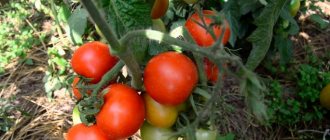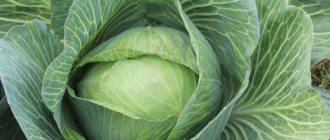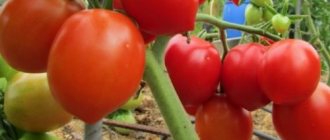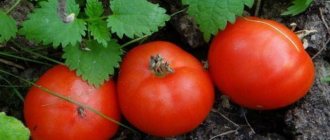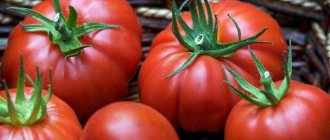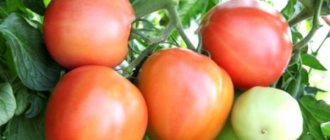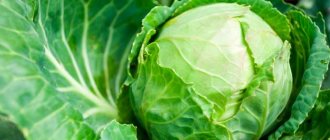Breeders are constantly working to develop new types of crops, adapting them to different weather conditions and the needs of gardeners. In recent years, many representatives of Solanaceae have appeared that can be grown in middle and northern latitudes, due to their resistance to specific climates.
Eggplant Drakosha is a prominent representative of this type of variety; it can be grown in greenhouses and in beds, since it is resistant to temperature changes and various diseases. It is distinguished by tasty and large fruits that ripen in up to 120 days. It has gained popularity among gardeners due to its good taste and ease and speed of cultivation, since the bush does not require additional pruning and tying, but at the same time produces juicy pear-shaped fruits without bitterness.
History of variety selection
Drakosha is a full-fledged variety, bred specifically for cold climates. The originator of the variety is a well-known agricultural company in Russia, the author of many modern varieties and hybrids of garden plants. The goal of the selection was to create a variety with universal fruits (using both fresh and canned fruits), capable of growing in open ground from mid-May and not requiring additional formation.
The variety was bred in 2006 on the basis of the early-ripening and cold-resistant Black Dragon variety, which is an East Asian subspecies of serpentine eggplants from China. Thanks to successful crossing with local eggplants, it was possible to obtain fruits of a classic shape and sufficient weight. The following is a description of the Drakosha eggplant, its photos and reviews from gardeners.
Eggplants for the winter – “Medallion” and “Dragon” starring
Who doesn’t want to sit comfortably on a dark winter evening and enjoy their favorite preparation? I’ll share with you a wonderful recipe for eggplants for the winter - I cooked it for the first time, they suggested this recipe to me, and I followed all the instructions from start to finish. Please don't judge harshly.
Eggplant preparation with hot pepper
The key ingredients here are eggplant and hot pepper. And ours are not simple, but from the POISK Agroholding - wonderful representatives of the “Four Summers” series.
“Medallion” and “Dragon” were born from these bags
So, what do we need to prepare such a preparation:
- eggplants - 2 kg,
- hot red pepper - 160 g,
- garlic - 120 g,
- parsley - a large bunch,
- cilantro - a large bunch,
- onions - 600 g,
- oil - 400 ml,
- wine vinegar 6% - 150 ml,
- salt - for salting eggplants,
- sugar - to taste.
Read also: How to grow a pear from a seed
The cooking procedure is as follows:
- Cut the eggplants into slices, add salt, leave for 1 hour and gently squeeze.
- Pour oil into a saucepan (or large saucepan), bring to a boil, add eggplants and simmer until pink-beige, stirring gently.
- Meanwhile, pepper, garlic, and herbs are passed through a meat grinder and mixed with vinegar.
- Cut the onion into slices.
- Add the onion and other ingredients to the eggplants and simmer over low heat until tender - for me it took about 30-40 minutes.
- During the cooking process, gradually add sugar little by little and taste. Here, as you like, to your taste. By the way, there was no sugar in the basic recipe, but I always add it to reduce the sourness from the vinegar.
- Place in dry, sterilized jars and seal.
- Wrap until completely cool.
The eggplants turned out very tasty, tender, aromatic, spicy.
And now a little about our main characters - “Medallion” and “Dragon”. As already mentioned, they are from the “Four Summers” series from the POISK Agroholding. This series includes crops that can be grown in pots on a windowsill or balcony. But why not grow them in greenhouse conditions in the ground? Therefore, they had a wonderful summer in the mini greenhouse. Accordingly, the bushes were not “potted” size.
Close-up
These are the eggplant bushes
On the bush they are already turning red
In technical maturity
They didn’t get sick with anything, no one tried to “bite” them off. I am very pleased with the taste, germination, development, and productivity - I will definitely plant them next year. And the size of the bushes is suitable for a mini greenhouse.
I recommend “Medallion” eggplants and “Dragon” hot peppers to everyone - they make wonderful preparations. You can grow it at home, and you will have “four summers” all year round, according to the name of the series.
Here I am, a “mini” eggplant
Description of eggplant Drakosha
The plant is a bush with a height of about 80-110 cm. The shape of the stem and leaves is characteristic of most Solanaceae. The strong, dark green stem grows almost vertically upward. Alternate leaves located on thick and long petioles form a relatively sparse crown, unable to hide large fruits from external view.
The pubescence of the leaves is quite rigid, making them appear rough and even prickly. The color of the leaves is light green, however, by the end of summer a barely noticeable purple tint appears on them.
Eggplant Drakosha is a monoecious plant with bisexual flowers. The flowers themselves are quite large - up to 5 cm in diameter, purple or white-violet. They are rarely located alone. Most often there are 5-6 flowers in an umbellate inflorescence.
Typically, flowering of the Drakosha variety occurs in early May - early June, although the timing may vary slightly depending on the time of planting. The Drakosha variety is an early ripening variety. The fruits ripen approximately 1.5 months after flowering (from 100 to 120 days from planting, depending on the climate). Peak yield occurs at the beginning of July.
Important! Eggplants are never eaten when fully ripe, as this causes them to lose their flavor and become extremely fibrous. Technical ripeness of eggplants occurs approximately 2-3 months before full ripeness.
Eggplant Drakosha can be grown both in a greenhouse and in open ground. In the case of greenhouse cultivation, seedlings can be planted in greenhouse soil in late April-early May. Directly into open ground - no earlier than the first ten days of June.
Description of fruits
The Drakosha eggplant fruits are common eggplant fruits that have some characteristic varietal characteristics. In particular, the shape of the berries of the Drakosha variety is not elongated, but pear-shaped.
The color of Drakosha fruits is deep purple. The skin has a pronounced gloss. There is no waxy coating on the fruits. Fruit sizes:
- length 16-21 cm;
- average diameter: 8-9 cm;
- thickening diameter – up to 16 cm.
The average weight of the fruit is 200-300 g, however, there are also giants up to 600 g. Moreover, they are not overripe, but have normal gastronomic qualities.
The pulp of the Drakosha variety has a whitish tint, it is sweetish, without any fiber. There is no bitterness even at late ripeness dates.
Growing
The last weeks of February and the beginning of March are a great time to sow seeds. When one or two leaves appear on the stems, you can begin picking. Seedlings can be planted in a greenhouse as early as mid-May, and in open soil no earlier than early June. In June, you will need to remove underdeveloped ovaries and flowers from the plants, and leave only 5–6 of the largest and strongest.
Important! Eggplants are difficult to transplant. You can immediately plant the seeds in disposable cups or boxes with separate containers, so that you can easily replant the sprout along with a small amount of soil.
Growing Tips:
- You need to choose only high-quality seeds. You should not save on this, so as not to pay twice later if your eggplants do not grow;
- You should take a responsible approach to choosing a site for growing eggplants. They do not tolerate proximity to other representatives of nightshade crops;
- To prevent seedlings from becoming lethargic, use containers of the correct shape and size. The plant may simply not survive in a cramped or, conversely, too large container;
- Before sowing, do not forget to treat the seeds. This will protect the plant itself and everything that grows around it from infections;
- plant seedlings on time. Eggplants need time to take root in the new soil and begin to develop, so do not delay replanting. For accuracy, please refer to the information on the packaging.
Characteristics of the variety
The Drakosha eggplant variety has excellent characteristics, however, they can be fully realized only by using the correct agricultural technology. In particular, it is believed that without the use of greenhouse shelters, obtaining maximum volumes of eggplant harvest is quite problematic.
Productivity and fruiting
Fruiting of the Drakosha variety begins in July and lasts about a month. During this period, zucchini is removed in a state of technical ripeness, suitable for consumption.
On average, up to 7-8 large fruits are grown on one bush of the Drakosha variety per season, which corresponds to a yield per bush of about 1-1.5 kg. At the same time, the planting density is such that the plant yield is up to 6 kg per 1 sq. m.
An increase in yield can be achieved by extending the flower setting period and creating the necessary conditions for the formation of large fruits. For this purpose, it is recommended to plant the Drakosha eggplant not in open ground in June, but in a temporary greenhouse in May, which must be removed after 1-1.5 months.
Area of application of fruits
The main goal of the breeding was to obtain a universal high-yielding variety, and the creators succeeded. Due to the complete absence of bitterness in the fruits of the Drakosha variety, they can be used in any type of eggplant dishes without any pre-treatment.
They are fried, stewed, baked, pickled and made into various types of snacks - from caviar to sauces. In addition, the fruits of the Drakosha variety can be used in any type of canned food. This can be either regular fermentation and salting, or preservation using marinade.
The fruit pulp generally tolerates freezing well.
Resistance to diseases and pests
Eggplants of the Drakosha variety have high resistance to fungal infections, in particular late blight and gray rot. There have been no recorded cases of mosaic virus disease in this variety.
Among the pests, leafhoppers can appear, which are a source of phytoplasma bacteria that cause the appearance of stolbur. This causes the leaves to harden and wrinkle.
Isolated cases of blackleg may occur, but this is primarily due to excessive watering. As a rule, when the amount of moisture is normalized, the spread of the disease stops.
Advantages and disadvantages of the variety
Advantages:
- excellent taste;
- versatility in application;
- high productivity;
- resistance to most diseases;
- resistance to sudden cold snaps and other vagaries of weather;
- long fruiting.
Flaws:
- To obtain high yields, greenhouse cultivation is necessary, even in warm climates.
Characteristics
Eggplant "Drakosha" is an early ripening variety. From the moment of germination to the full ripening of the fruit, it takes from 100 to 120 days. Can be grown in open ground or in greenhouses. The height of the plant can reach up to 1 m. The color of the fruit, like all eggplants, is dark purple, the skin is shiny and smooth. The weight of one fruit is about 300 g, and the length is up to 21 cm. The shape of the fruit is pear-shaped. The variety is disease resistant, which guarantees a good harvest. It bears fruit abundantly, especially if grown in a greenhouse. Under such conditions, you can harvest up to 5 kg of fruit per m2.
The taste is pleasant, there is no bitterness. Suitable for preservation. The variety was bred specifically for growing in unfavorable conditions. It grows and develops even in infertile soil. Does not require complex care. This variety grows and develops quickly. The high yield of “Drakosha” eggplants will allow you to collect a lot of fruits even in a small area.
The variety was bred very carefully, taking into account all possible problems, diseases and bad weather conditions. Therefore, it is ideal for any climate and can easily withstand both strong winds and drought. Eggplant is resistant to most possible diseases. Even with poor exposure to sunlight, this variety will grow and be pleasing to the eye.
Features of planting and care
Seedling
In our climate (even in the southern regions) eggplant of the Drakosha variety is grown exclusively by seedlings. The main differences in growing this variety are the timing of planting seedlings.
Since the Drakosha eggplant, according to its description, is early ripening, it is advisable to plant it in early March, or better yet, at the end of February. The originating organization determines the timing of planting seeds for seedlings in the period from February 25 to March 5.
Growing seedlings does not have any features associated with varietal differences. A two- or three-component mixture of leaf (or leaf and turf) soil and peat is used as soil for seedlings. Before planting, seeds should be soaked for half an hour in a solution of 0.2% potassium permanganate. They do not need any pre-treatment or stratification.
Plants can be planted either in individual containers or in a common box, however, the first method is preferable, since young plants are difficult to tolerate damage to the root system during transplantation.
Usually, 2-3 seeds are placed in one hole to increase germination. Picking plants, carried out after the first leaves appear, leaves the strongest of the sprouted ones.
Planting in open ground
Planting in a greenhouse is carried out from May 1 to May 15, in open ground - from May 15 to June 15, depending on climatic conditions. Plants transplanted into a greenhouse do not require hardening. Otherwise, seedlings are hardened within 10 days before planting.
Plants are planted according to a pattern of 60 cm between plants and 40 cm between rows. The planting procedure is also standard: in holes up to 10 cm deep, a layer of humus up to 5 cm thick should be placed on the bottom. Young plants are installed in the center of the holes, covered with topsoil, compacted and watered abundantly.
Care after transplant
Further care for them is standard: it includes watering once every 3-5 days, depending on the moisture content of the top layer of soil. The formation of a bush for this variety is not necessary, since the bush, despite its relatively tall growth, is quite compact. Typically, the stem is tied to the support at one or two points.
Feeding may take the following form:
- planting: 30 g of superphosphate, 15 g of ammonium sulfate and 15 g of potassium chloride per 1 sq. m;
- during flowering: per 1 sq. m in 10 liters of water dilute 1 liter of mullein or 500 ml of chicken droppings;
- during fruiting: once every 2 weeks per 1 sq. m solution of 40 g of superphosphate in 10 liters of water.
Typically, fertilizing is combined with watering.
The soil under the plants should be loosened regularly. This is also done during watering - using any convenient tool (for example, a small rake with 3-4 teeth), the top layer of soil is loosened to a depth of about 2-3 cm.
Improved harvest quality
Usually 1-2 weeks after transplanting the plant, it begins to flower. Pollination occurs both with and without the participation of insects. In any case, human intervention is not required at this stage.
Important! When the ovaries are already formed, it is necessary to carefully examine them to ensure their normal appearance and development. If wrinkled or too bent ovaries are found, as well as those that grow very slowly, they should be removed.
This will help the plant not to spend extra resources on the formation of fruits with a deliberately low weight, which will increase the overall yield of the plant.
Landing
At the end of February or beginning of March, seedlings are sown for seedlings. Seeds and nutrient substrate are prepared in advance.
The seeds are soaked in a warm solution of potassium permanganate or hydrogen peroxide, then they are washed and placed in a solution of a growth stimulator.
To speed up germination, you can germinate the seeds. They are placed in a damp cloth and placed in a warm place for a day.
The nutrient substrate is mixed from turf soil, peat, humus, mineral fertilizers and drainage. Disinfect by spilling with a solution of potassium permanganate or fungicide. You can calcine the soil in a furnace.
Sowing of seeds is carried out in individual or common containers. In common boxes after germination, seedlings are picked as soon as the seedlings acquire 2-3 true leaves. Sow the seeds to a depth of 1 cm. Germinate the seedlings at +20-25 degrees under glass or film. During the entire period of seedling development, good lighting is necessary. When there is a lack of daylight, phytolamps are used.
Young bushes are transplanted to the site according to a 60 by 40 cm pattern.
